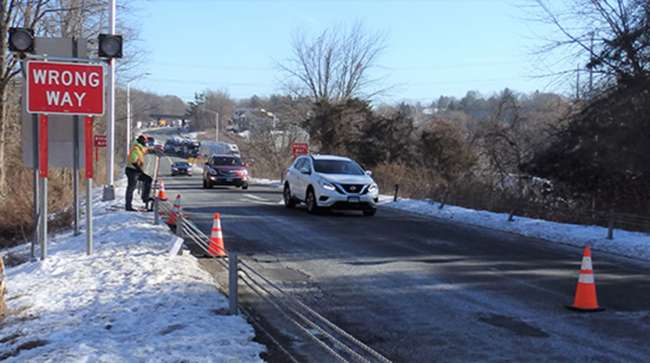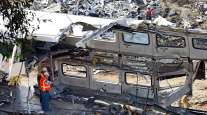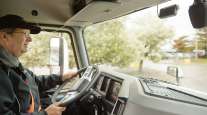Staff Reporter
Connecticut Combats Wrong-Way Driving

[Stay on top of transportation news: Get TTNews in your inbox.]
High-tech countermeasures against Connecticut’s burgeoning 550% jump in wrong-way crashes will result from a law Gov. Ned Lamont enacted to install new alert systems statewide on 120 highway exit ramps.
Frequently resulting in fatalities due to high speeds, these crashes occur when a driver, often in an impaired condition, enters a roadway while traveling in the wrong direction.
“It is shocking how quickly the number of wrong-way driving incidents has accelerated over these last couple of years, and we need to do more to prevent them,” Lamont declared June 13 when signing former House Bill No. 6746. The new law is Public Act 23-51 on wrong-way driving detection and prevention. The legislation, which takes effect Oct. 1, was introduced by the House Transportation Committee.
During 2022 in Connecticut, annual records indicated wrong-way crashes tripled to 13 (with 80% of drivers deemed impaired) that resulted in 23 deaths. This number of accidents was 550% higher compared with two wrong-way crashes in 2020.

Lamont
Lamont said, “Reversing this trend requires a comprehensive approach that not only involves infrastructure upgrades using advanced technology, but also requires a heightened awareness by drivers every single time they are entering a highway. This is an issue that we cannot take lightly, and we must continue researching new and emerging methods of preventing wrong-way driving incidents.”
The new law orders the Connecticut Department of Transportation to expand its efforts to implement wrong-way driving countermeasures as well as driver’s education programs (how to lower wrong-way driving and actions to take when a vehicle is seen traveling in the wrong direction).
The new law enables CTDOT to expand to 120 more high-risk sites its current installations of wrong-way countermeasures. These systems include a 360-degree camera to detect wrong-way vehicles and large signage that activates to rapidly flash bright red LED lights warning drivers they are going the wrong way.

Hayden Cardiff, co-founder and chief innovation officer of Idelic, discusses predictive analytics software and scoring driver practices. Tune in above or by going to RoadSigns.ttnews.com.
Planned high-tech deployments are new thermal cameras able to verify if wrong-way drivers fail to self-correct and issue real-time notification about the dangerous incidents to both CTDOT and Connecticut State Police. Cameras also will provide authorities with snapshot photos or video streams of wrong-way drivers entering highways.
CTDOT is adding retro-reflective strips to guide rails that look white and yellow in color for drivers traveling the correct direction, but reflect red when viewed by wrong-way drivers. It also is installing in-pavement markers (in-laid reflectors) to outline the two white directional arrows at the end of off-ramps and on the edge line near guide rails.

Eucalitto
Garrett Eucalitto, CTDOT commissioner, reported in March to state legislators that most wrong-way crashes in the state happen between 11 p.m. and 4 a.m.
“CTDOT conducted an analysis of over 700 ramp locations in Connecticut, especially where on- and off-ramps are located on the same side of the roadway and has identified 236 locations as high-risk. Research has shown that on and off-ramps on the same side of the roadway, and ramps near establishments serving alcohol, have a higher risk of experiencing a wrong-way event,” Eucalitto stated.
One section of the new law requires CTDOT to provide a grant to the University of Connecticut to test and analyze using directional rumble strips to alert drivers through vibration and sound when their vehicles are moving in the wrong direction. Also, CTDOT must submit a report by Jan. 1, 2025, to the Legislature about test results and possible recommendations about installing directional rumble strips throughout the state.
In March, Lamont announced CTDOT’s new “One Wrong Move” public awareness campaign about the dangers of wrong-way driving using television, radio, an online video and billboards.
In July 2022, he authorized $20 million in state bond funds be directed to CTDOT to buy and install advanced wrong-way driving technology along the state’s highways and roads. That technology used motion sensors to detect a driver entering a highway exit ramp from the wrong direction and rapidly flash warning LED lights.




